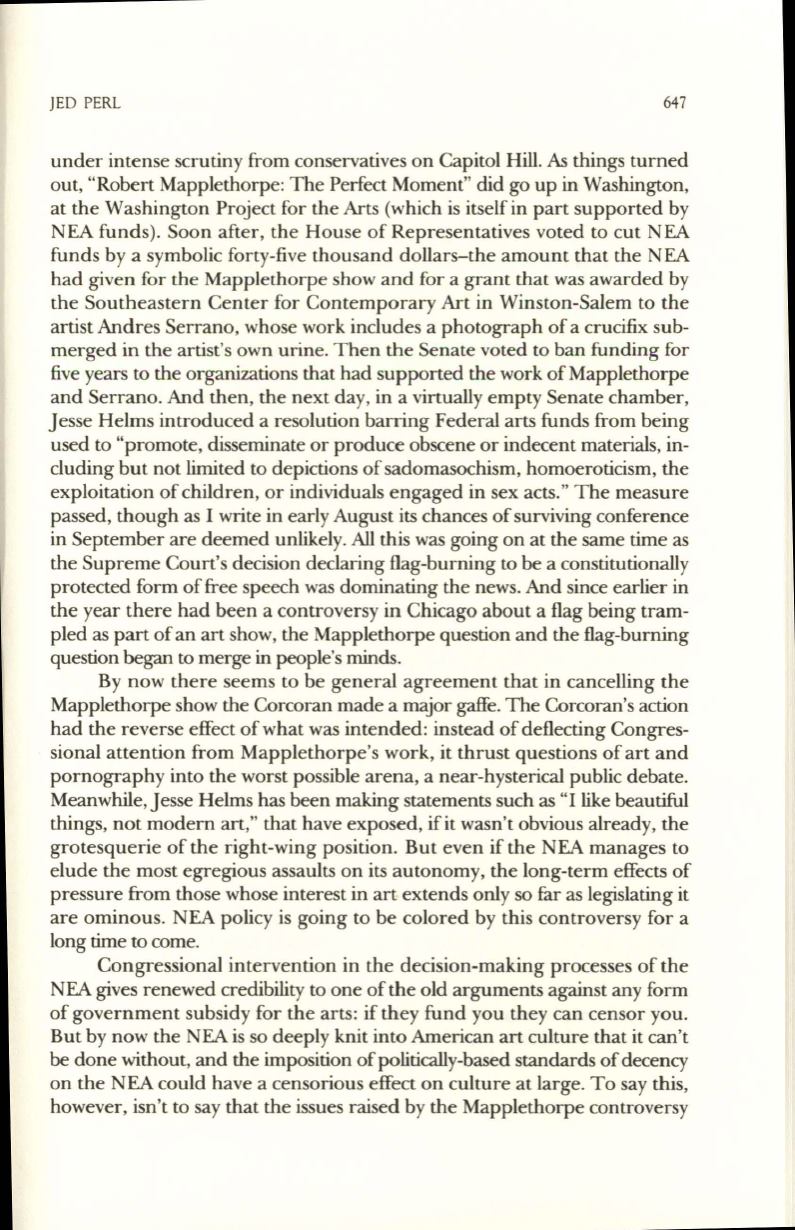
JED PERL
647
under intense scrutiny from conservatives on Capitol Hill. As things turned
out, "Robert Mapplethorpe: The Perfect Moment" did go up in Washington,
at the Washington Project for the Arts (which is itself in part supported by
NEA funds). Soon after, the House of Representatives voted to cut NEA
funds by a symbolic forty-five thousand dollars-the amount that the NEA
had given for the Mapplethorpe show and for a grant that was awarded by
the Southeastern Center for Contemporary Art in Winston-Salem to the
artist Andres Serrano, whose work includes a photograph of a crucifix sub–
merged in the artist's own urine. Then the Senate voted
to
ban funding for
five years to the organizations that had supported the work ofMapplethorpe
and Serrano. And then, the next day, in a virtually empty Senate chamber,
Jesse Helms introduced a resolution barring Federal arts funds from being
used to "promote, disseminate or produce obscene or indecent materials, in–
cluding but not limited to depictions of sadomasochism, homoeroticism, the
exploitation of children, or individuals engaged in sex acts." The measure
passed, though as 1 write in early August its chances of surviving conference
in September are deemed unlikely. All this was going on at the same time as
the Supreme Court's decision declaring flag-burning to be a constitutionally
protected form of free speech was dominating the news. And since earlier in
the year there had been a controversy in Chicago about a flag being tram–
pled as part of an art show, the Mapplethorpe question and the flag-burning
question
began
to merge
in
people's minds.
By now there seems to be general agreement that in cancelling the
Mapplethorpe show the Corcoran made a major gaffe. The Corcoran's action
had the reverse effect of what was intended: instead of deflecting Congres–
sional attention from Mapplethorpe's work, it thrust questions of art and
pornography into the worst possible arena, a near-hysterical public debate.
Meanwhile, Jesse Helms has been making statements such as "I like beautiful
things, not modern art," that have exposed, if it wasn't obvious already, the
grotesquerie of the right-wing position. But even if the NEA manages to
elude the most egregious assaults on its autonomy, the long-term effects of
pressure from those whose interest in art extends only so far as legislating it
are ominous. NEA policy is going to be colored by this controversy for a
long time to come.
Congressional intervention in the decision-making processes of the
NEA gives renewed credibility to one of the old arguments against any form
of government subsidy for the arts: if they fund you they can censor you.
But by now the NEA is so deeply knit into American art culture that it can't
be
done without, and the imposition of politically-based standards of decency
on the NEA could have a censorious effect on culture at large. To say this,
however, isn't to say that the issues raised by the Mapplethorpe controversy


